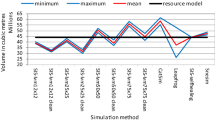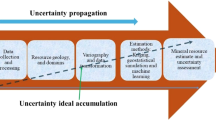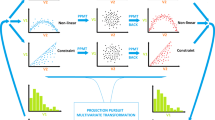Abstract
Mineral resource classification is of paramount importance for mining industry. The main challenge for this, however, is related to the geostatistical modeling approach, in which there is no unique algorithm for such a significant act. The deterministic approaches such as kriging, indeed is not proper, because of its smoothing effect and ignoring the proportional effect that lead to possible misinterpretation of kriging variance. As an alternative, stochastic simulation based on modeling the continuous variable can be employed. Besides of legitimate criticism against this approach, it is still usable for mineral resource classification. One of the dispute is related to setting parameters and choosing the optimum Gaussian simulation algorithm. In this study, an alternative is proposed in reliance on stochastic modeling of categorical variables rather than continuous variables such as estimation domains and rock types. The algorithm is founded on probability assumption, in which definition of thresholds for different categories can be manipulated with reference to opinion of the competent person as defined in JORC code.
Access provided by Autonomous University of Puebla. Download conference paper PDF
Similar content being viewed by others
Keywords
1 Introduction
Mineral resource classification is necessary for public reporting and internal company assessments, financial institutions etc. [1]. This approach is based on the level of confidence inferred from geologically modeled block. Based on JORC code, a mineral resource can be classified into “Measured”, “Indicated” and “Inferred”, depending on the level of confidence (www.jorc.org). The modeling process for deriving the corresponding category, can be either deterministic or stochastic. The conventional approach of stochastic block categorization is mostly based on geostatistical simulation of continuous variable such as grade of interest. Although this approach is trustworthy; however, the choice of proper geostatistical simulation algorithm and setting the relevant parameters may be challenging [2]. In this study, an alternative of mineral resource classification is proposed on the basis of stochastic modeling of categorical variables (e.g., lithologies, rock types) rather than continuous variables through a probabilistic paradigm. The results are illustrated through an actual case study.
2 Methodology
The proposed methodology is based on quantification of geological uncertainty. In this technique, underlying categorical values are available through the boreholes and one needs to calculate the uncertainty of each rock unit at unsampled locations. This step can be implemented by any stochastic paradigms such as multiple-point statistics, sequential indicator simulation and plurigaussian simulation [3], depending on the complexity of geological formation and their contact relationships. Plurigaussian simulation as an extension of the truncated Gaussian simulation is more capable of handling the complex contacts relationship among the geo-domains. In this context, the allowed and forbidden contacts can be injected into the modeling process. In a nutshell, it has found wide acceptance between the practitioners for modeling the petroleum reservoirs. Once the simulated categories are available at targeted locations, the uncertainty or probability of finding that rock unit different form others can be straightforwardly computed for each node. Through the probability maps, a model (one unique map) can be constructed by selecting, for each grid node, the most probable rock type domain. The value of this map is varying between 0 and 1, useful for quantification of uncertainty at target nodes. The high amount of this measure (close to 1) indicates that one is certain about the simulated value for that location irrespective of the type of simulated rock unit and low amount of this probability map (close to 0) implies that one is uncertain about the availability of that simulated rock unit irrespective of the simulated category. This interpretation explicitly pronounce the level of availability of the information such as sampled locations and boreholes, for which the confidence in simulated rock unit can be defined in each node. The proposed approach in this paper, takes into account this most probable map to classify the mineral resources in each block into measured, indicated and inferred. This can be realized through break points in the graph of probability plot where the global distribution of most probable values are illustrated. The advantage of this approach is that, the selection of the thresholds of interest for the purpose of classification depends on the opinion of competent person and should be derived manually. The procedure of the proposed algorithm is:
-
1.
Exploratory data analysis of rock units through borehole data
-
2.
Selection of optimum approach for probabilistically domaining of each rock unit taking into account the complexity
-
3.
Computation of most probable map through probability map of each rock unit
-
4.
Inference of thresholds for mineral resource classification in the probability plot of most probable values
-
5.
Classification of each block based on the derived thresholds and underlying breaking points
This algorithm is illustrated through an actual case study.
3 Actual Case Study
In order to show the performance of the proposed approach for mineral resource classification, a dataset from a porphyry copper deposit in Chile is now employed. The data consist of 2,376 composites from an exploratory borehole campaign [4]. The composites are 12 m long with semi-regular sampling pattern. Each composite is assigned a geological domain which is related to lithology type. The rock codes were originally six, however, they were grouped into three main types (Fig. 1):
-
(a)
Granodiorite: this is host rock where breccia intruded. It is mostly located in eastern and southern parts of the deposit.
-
(b)
Tourmaline breccia: This breccia has granodiorite clasts with minerals correspond to tourmaline and sulphides such as chalcopyrite, pyrite, molybdenite, and some bornite. Its emplacement is related to the main alteration-mineralization event. This rock has the highest mean grade and is centrally located in the deposit.
-
(c)
Other breccias: They are organized by three different breccia types and outcrop in the western and southern areas of the deposit. Their emplacement is simultaneous or more recent than the intrusion of tourmaline breccia, relocating and diluting it.
Based on exploratory data analysis, roughly 15%, 69% and 17% are the proportion of region that are dominated by Granodiorite, Tourmaline breccia and other breccia, respectively. Based upon the geological interpretation and local distribution of these three rock types, Granodiorite is in direct contact with Tourmaline Breccia and Tourmaline Breccia is in contact with other breccia. Therefore, there is a forbidden contact between Granodiorite and other breccia. This implies that there is a restriction in contact relationship and justify applying the truncated Gaussian simulation approach for probabilistically domaining the rock types. To do so, the flag of interest is illustrated in Fig. 2. As can be seen, there exist one Gaussian random field for modeling purposes. For the theory of truncated Gaussian simulation, the interested readers are referred to the reference therein [3, 5, 6].
The next step, following inference of flag and truncation rule, is to compute the theoretical model of variogram for the Gaussian sought. This can be carried out through an iterative manner between experimental variogram of indicator data and theoretical variogram of Gaussian data [3, 6] (Fig. 3). The fitted model is spherical isotopic with the range of 300 m and show a very long range relatively to the dimension of the drilling grid, for which a non-stationary variability for each rock type may persist. This also can be corroborated as well, when one is investigating the local distribution of each rock type in the region (Fig. 1). For instance, Granodiorite can be just found in the right side of the area whereas the other breccia can only be met along the left side of the region. Therefore, such a long range of variogram modeling is apparently evident. The underlying formulae is as follow:
Once the variogram model of Gaussian values is derived, the categorical data can be converted to Gaussian values corresponding their truncation rule as presented in Fig. 2 by Gibbs sampler. For this purpose, two thresholds defining each rock type can be derived as −1.0407 and 0.9826 for the first and second threshold. The first threshold is only taking into account the first rock type, Granodiorite and the second one introduces the proportion of Granodiorite and Tourmaline breccia together. The inverse of proportions can be inferred from normal standard Gaussian cumulative density function. After this conversion, the Gaussian values at sample locations can be considered as conditioning data for multi-Gaussian conditional simulation. This step can be implemented through any Gaussian simulation approach, however, in this study; we use turning bands simulation for producing the realizations. Based upon the truncation rule in Fig. 2, the Gaussian maps can be truncated to the categorical maps, so that each grid node, show the possible occurrence of the rock types (Fig. 4). Following the proposed approach in this study, we continue working on the calculation of probability of finding each rock type at either grid nodes. This gives an insight about the probable area for searching that specific rock type. The probability map for each rock type is illustrated in Fig. 5.
The probability maps allow calculating the most probable maps at each block location. For this, it is necessary to identify the maximum probable value at each block over the probability of rock types. For instance, if the probability of Granodiorite is 0, Tourmaline breccia is 19% and other breccia is 81% for block No. 1, then the most probable value for this block will be 81%, showing the fact that satisfying density of information (i.e., borehole data) of other breccia around this block exist and one is certain about the availability of the surrounding information. In contrast, block No. 2, may show different characteristics, in such a way that the probability for Granodiorite is 48%, Tourmaline breccia is 51% and other breccia is 1%. In this block, the most probable value is 51%, which is quite low relatively to block No. 1. This corroborates that the supporting information surrounding this block is poor or rather far from the conditioning data.
Figure 6 shows the most probable map. The location close high probability indicates that there are enough information for that block to be simulated and one is confident in the derived value for that block. The location with low probability indicates that one is not confident in the simulated value. As can be seen, comparing to Fig. 4 that show the simulated rock types, the most probable areas are located on the place that the borehole information is available, and the low values manifest themselves through the boundary of the lithologies. Following the proposed approach for mineral resource classification, the next step is to derive the thresholds that can capture three zones based on the level of confidence, indicating measured, indicated and inferred categories. One of the useful tools, for this purpose, however, can be showing the distribution of the underlying variable i.e., most probable values on the probability plot. In principle, this graph is for assessing the distribution whether or not a dataset follows the normal or lognormal distribution. The data is plotted against a theoretical distribution so as to the points should form approximately a straight line. In this graph, the breaking points can show the different populations, for which in the case of resource estimation, can introduce the area of each category (Fig. 7).
As can be seen in Fig. 7, the breaking points show the thresholds, representing the different populations and categories. Based on this graph, the blocks with most probable value less than 0.52, between 0.53 and 0.94 and above 0.95 can be classified into inferred, indicated and measured, respectively. The dashed green lines over this graph provides this opportunity to identify the underlying thresholds in possible ranges (between two green lines). This can be corroborated in accordance with the opinion of competent person who is responsible for this type of deposit. Once the block are categorized, the continuous variables can be estimated or simulated taking into account the uncertainty quantified through the stochastic modeling of geological domains. Since the category of all the blocks are identified, recovery functions such as tonnage, mean grade above cut-off and metal quantity can be reported in either categories (Fig. 8).
4 Conclusion
Mineral resource classification is important in mining industry and is vital for public reporting of mineral resources and ore reserves based on JORC code. In this study, an algorithm is proposed for this classification based on modeling the geological domains. In this approach, the categorical variables, introducing the estimation domain should be first modeled in a stochastic manner. Second, through producing different scenarios, one can calculate the probability maps for each category. Through these probability measures, the third step, is to calculate the most probable value at each grid node and produce the most probable map. Since, this value is obtained from the probability of each categorical domain, the high values indicate that the simulated values irrespective of the type of simulated rock type is significant and can show that the surrounding information is good enough. In contrast, the low values show that one is less certain about the simulated category and the supporting information for modeling that category in that block may be poor. Based on this concept, different thresholds can be defined by plotting the most probable values in a probability plot and infer the underlying thresholds. The proposed algorithm showed that this method is capable of handling the uncertainty even in the captured thresholds, in which the competent person can easily comment on that and classify the resource sought based on JORC code.
References
Battalgazy, N., Madani, N.: Categorization of mineral resources based on different geostatistical simulation algorithms: a case study from an iron ore deposit. Nat. Res. Res. 28(4), 1329–1351 (2019)
Rossi, M.E., Deutsch, C.V.: Mineral Resource Estimation. Springer, Berlin (2014)
Madani, N., Emery, X.: Simulation of geo-domains accounting for chronology and contact relationships: application to the Rio Blanco copper deposit. Stoch. Environ. Res. Risk Assess. 29, 2173–2191 (2015)
Ortiz, J.M., Emery, X.: Geostatistical estimation of mineral resources with soft geological boundaries: a comparative study. J. South Afr. Inst. Min. Metall. 106, 577–584 (2006)
Armstrong, M., Galli, A., Beucher, H., Le Loc’h, G., Renard, D., Renard, B., Eschard, R., Geffroy, F.: Plurigaussian simulations in geosciences. Springer, Berlin (2011)
Madani, N., Emery, X.: Plurigaussian modeling of geological domains based on the truncation of non-stationary Gaussian random fields. Stoch. Environ. Res. Risk Assess. 31, 893–913 (2017)
Author information
Authors and Affiliations
Corresponding author
Editor information
Editors and Affiliations
Rights and permissions
Copyright information
© 2020 Springer Nature Switzerland AG
About this paper
Cite this paper
Madani, N. (2020). Mineral Resource Classification Based on Uncertainty Measures in Geological Domains. In: Topal, E. (eds) Proceedings of the 28th International Symposium on Mine Planning and Equipment Selection - MPES 2019. MPES 2019. Springer Series in Geomechanics and Geoengineering. Springer, Cham. https://doi.org/10.1007/978-3-030-33954-8_19
Download citation
DOI: https://doi.org/10.1007/978-3-030-33954-8_19
Published:
Publisher Name: Springer, Cham
Print ISBN: 978-3-030-33953-1
Online ISBN: 978-3-030-33954-8
eBook Packages: EngineeringEngineering (R0)












